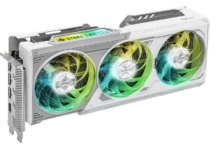Antec has expanded its Phantom series of silent power supply units with a more powerful model. Antec Phantom 500W sports mroe power than its predecessor, but is in turn not passive. Will this affect the noise?
For some users the noise-level is everything. Your computer should be so quiet that you can’t tell whether it is in the room or not. Noise is actually one of our time’s biggest problems. And by that I don’t mean that you can get tinnitus from a regular computer. No, we are all exposed to different types of sounds, some harmful and some not. But silence inside our own home isn’t too much to ask for.
Here at Nordichardware, we have already taken a look at Antec’s silent power supply, Phantom 350W, and today it’s time for the bigger brother Phantom 500W. Antec Phantom 500W is an upgraded model with more power and a fan. But what is a fan doing inside a totally silent power supply you might wonder? Antec have probably (my speculation) figured out that if you you utilize that much power you probably have a system consuming a lot of power (e.g. a gaming rig) and then the sound that the power supply generates drowns among the rest. Video card coolers are often loud and will therefore make the sound from the PSU negligible
With that said I want to welcome you to our review of Antec Phantom 500W, a both heated and enlightening review (the PSU is equipped with both heatsinks and an oblong light strip).
| Specifications | |
|---|---|
|
Voltage/Current
|
|
|
+3.3VDC
|
30A
|
|
+5VDC
|
30A
|
|
+12VDC
|
17A
|
|
+12VDC (ATX12V)
|
18A
|
|
-5VDC
|
–
|
|
-12VDC
|
0.8A
|
|
+5VSB
|
2A
|
|
Max. load Total
|
500W
|
|
Max. load +3.3V & +5V
|
249W
|
|
Connections
|
|
|
Molex
|
4
|
|
Floppy
|
1
|
|
Serial-ATA
|
4
|
|
PCI-E
|
2
|
|
Other connections
|
ATX12V
|
|
Other specifications
|
|
|
Fans
|
1x 80mm
|
|
Certifications
|
UL, CUL, VDE, SEMKO, DEMKO, NEMKO, FINKO, CE and CB
|
|
Other
|
Gold plated contacts, power cable
|
|
Warranty
|
3 years
|
|
Price
|
~$160
|
The Antec Phantom 500W package is really big and heavier than most. The size of the box is not an attempt to claim itself on power supply market by saying “bigger is better”, it simply wants to protect its power supply. The power supply consists mainly of aluminum and weighs in at 3.1kg (6.65Lbs). This is the heaviest power supply I have worked with so far and it’s understandable that the box is as big as it is since 3.1kg (6.65Lbs) will cause you a lot of pain if you happen to drop it on your foot. You simply need a great deal of protection in order to protect 3.1kg (6.65Lbs) of aluminum.
At the first glimpse inside the box it may look a bit lean: Manual, 4 screws, a power cord and the power supply. And that’s really all you need unless you’re after a bunch of stuff for added value, but this power supply is most of all for those who really know what they want; silence. However this PSU comes with a fan even though it’s supposed to be silent, this is a feature that Antec has given some extra thought though. They’ve decided to use a temperature controlled fan that starts when the temperature rises above the preset threshold; we’ll take a closer look at the fan later on.
Phantom 500W follows the ATX 2.2 standard. We did a short explanation about what ATX 2.2 brings when it comes to the power supply and you can read about it here. I would also like to point out that the ATX 2.2 standard gives the power supply developers the choice of including the -5 rail or not, and since most of the manufacturers today chose not to; owners of MSI’s motherboards better watch out before buying an ATX 2.2 power supply since those require the -5 power line.
Phantom 500W comes with a lot of different connectors, or more precisely 4 Molex, 4 Serial-ATA, 1 Floppy and 2 PCI-E connectors, and of course the crucial ATX connectors.With that many connectors Antec has really covered most needs and constructions. The fact still remains though, that many connectors will mean many and (often) long cables. Long cables make it hard to keep the inside clean and perhaps it would be a good idea to introduce modular cables with the Phantom series.
 |
 |
The power supply is surrounded by foam to protect it during transportation.
 |
 |
The power supply is heavier than a usual power supply using a conventional cooling system. Almost all of the weight consists of aluminum for the cooling and the top and bottom are covered with black aluminum heatsinks.
 |
 |
Antec is like most other manufacturers using a simple, but smart solution. You just remove a piece from the ATX connector and just like that it has gone from a 24-pin connector to a 20-pin.
If you’re wondering where the information about the fan has gone I can ensure you that I haven’t forgotten about it. You’ll hear more about the fan in the computer test, were it actually might be heard a little too much to your liking. With that said we’ll move on to our test bench were we’ll check to see if the voltages and ripple sticks within the margins.
Our synthetic tests are done in two parts, one low power test and one high power. The power supply runs for about a half hour, with an opening period of low power and then a high power test. During the low power test the three main voltages (+3.3V, +5V and +12V) are put under a load of about 1 Ampere each. This test is to see how the power supply works when “idle”.
During the high power test, the three voltage lines are put under maximum load to see if the power supply can keep the voltages and ripple within the thresholds. This is to see if the PSU can live up to its promises. Ripple and voltages are continuously measured throughout the two tests. The second stage is done in a regular computer. Well then, let us head into the land of heat development.
Antec Phantom 500W has no problems with the low power test and it is quiet, dead quiet. The PSU doesn’t even get lukewarm and you can’t really tell whether the power supply is turned on or not unless you check the light on the rear. The voltages are perfect and the ripple is at a minimum. Since everything is looking fine we move on to the high power test, and now the fan should start moving.
After thirty minutes we have fan spinning inside the power supply, alas there are both upsides and downsides. The power supply gets everything from lukewarm to really hot depending on the fan speed.
The voltages have decreased a bit but are still good and the ripple is nothing to worry about, but what makes you worry is the temperature of the power supply, and how it in turn affects the other components. Let’s install the PSU.
|
Test system
|
|
| Processor: |
AMD Athlon 64 3000+ Socket 754
|
| Chassi: |
Standard ATX
|
| Motherboard: |
Epox EP-8KDA3+
|
| Memory: |
512MB DDR-SDRAM
PC-3200 2.5-3-3-7 timings) |
| Graphic card : |
Abit Siluro FX-5600 DT 256Mb
|
|
Harddrive:
|
Maxtor Diamondmax 9 200GB
|
|
Software
|
|
| Operating system : |
Windows XP Professional SP1
|
|
Test program:
|
Sisoftware Sandra 2004
Seti (Boinc) Speedfan |
The test system is based on an AMD’s socket 754. The system is overclocked to 2,2 Ghz. Other than that we have one harddrive and a graphic card in the low end segment not worth mentioning. “Cool ‘n Quiet” has been deactivated, to prevent any odd results.
The voltages are looking good and the variations are small. But there is a downside to everything and this time it is the temperature inside the case. Our test computer was using AMD’s retail fan which has a built in fan controller. It simply registers the temperature and adjust the speed accordingly. This is how all temperature controlled fans work, nothing odd about that.
Now we arrive to what you’ve been waiting for: the fan. The construction is very simple here as well. Simply a small switch with three modes, 1-2-3, on the power supply. When set to mode 1 the fan is activated when the temperature inside the power supply reaches 40°C (104°F). After that the fan tries to keep the temperature down with a fan with variable speed. Mode 2 and 3 have thresholds at 47.5°C (118°F) and 55°C (131°F) respectively. Antec has come up with some nifty names for the different modes though; “High performance”, “Quiet computing” and “Virtually silent”. They say that overclockers and gamers should not use mode three; Virtually silent.
Now the problem I mentioned already in our review of the Antec Phantom 350W surfaces, namely that a quiet power supply needs to have sufficient peripheral cooling since it doesn’t move the hot air away by itself.
At the moment our test computer makes more noise more than usual. Some quick research shows that the noise is because that the power supply has raised the temperature inside the case so much that the fan on the processor cooler has reached its threshold and moved the the RPM to the max setting, since the temperature is getting close to 50°C (122°F). When I am about to check what mode the power supply is set to I discover that the switch can’t be accessed from outside the case but only from the inside. Why have they chosen to put a switch where it is the least accessible? Be sure to note that the power supply is not installed correctly on the picture below, the cables should come from the other side inside the case. The power supply is mirrored, partly because you can install it this way and partly to make the switch more accessible than if everything had been installed as usual with the switch against the side.
 |
Further I discover that the switch is set to mode one already, which means that you can’t lower the threshold anymore which makes you wonder. How will the power supply affect a more power consuming computer. If a computer as ours makes the temperature of the processors and inside the case climb to too high levels, what will happen with a real gaming rig? Remember Antec’s words that overclockers and games should not use mode three. I understand what they mean by that now.
With these new discoveries we introduce a new temporary test system with the properties the “Virtually silent” mode isn’t intended for, an overclocked gaming computer.
|
Test system 2
|
|
| Processor: |
AMD Athlon 64 3000+ Socket 939
|
| Chassi: |
Standard ATX
|
| Motherboard: |
Asus A8N-SLI
|
| Memory: |
1024MB DDR-SDRAM
PC-3200 2.5-3-3-8 timings) |
| Graphic card : |
MSI NX7800GT 256MB
|
|
Harddrive:
|
Maxtor Diamondmax 9 200GB, 2x Maxtor Diamondmax 10 300GB
|
|
Software
|
|
| Operating system |
Windows XP Professional SP1
|
|
Test program:
|
Sisoftware Sandra 2004
Futuremark 3Dmark2003 Speedfan |
Now we have some hotter hardware inside the case. Three harddrives, two in RAID 0, one overclocked processor, and a graphic card up to date to see if the power supply keeps the noise and the temperature down but still perform well.
Speedfan is used to measure temperature and fan speeds of the motherboard and processor, while Futuremark 3Dmark2003 was used to load the processor and video card.
We start with letting the computer run idle for a while. After literally having seen the heat inside the computer rise for 30 minutes it finally stops at the not so impressive 51°C (124°F). The temperature inside the case sets a new record at 44°C (111°F). This is achieved at mode one, I.e. the lowest threshold. 51°C (124°F) on the processor isn’t very promising when we are about to run 3Dmark2003.
As comparison we used Hiper Type-R 580W. A power supply with two fans, one 80mm and one 120mm, but above all a silent power supply.
The diagram clearly shows that the components inside the case gets hotter with Antec’s Phantom 500W. The computer is a tiny bit quieter with the Phantom PSU but the cost of the small margin is higher temperatures. An increase of the processor temperature during idle with Phantom 500W at 9°C (16°F) compared to Type-R can’t be neglected and a difference of 13°C (24°F) during load is on the verge of what I consider reasonable to pay extra for a marginally lower level of noise.
But, since Antec are careful to say that Phantom 500W should be installed in a well ventilated case we tested that as well, with the help of a adjustable 80mm fan. With a Phantom 500W and external fan the temperature is almost the same as with Type-R, but noise is then pretty much the same.
Antec is well known for its power supplys with more or less interesting solutions. It is also known for its high quality and Phantom 500W is no exception. Antec made a great contribution to the HTPC market with its Phantom 350W and has now added another to the genre with the Phantom 500W.
With Phantom 500W they aimed a bit too high though. What I’m going for is the fan, a fan that is there but not. They’ve gone for the HTPC market with the low noise properties the PSU has but also for those who are looking for a silent power supply with more power than a completely silent power supply can deliver.
Alas there are some negative things we have to say about the performance of the Phantom 500W. The difference compared to Phantom 350W is that it was intended for those who wanted to create complete silence, such as HTPC and one or two desktop computers with relatively low demands for the processor speed and graphic card. With Phantom 500W things are different since 500 Watt can be used to power a lot more. You can use it to set up a gaming computer with two graphic cards in SLI. Although Antec says that mode three (Virtually Silent), should not be used by a gamer. An SLI configuration consumes a lot of power and often create a lot of heat and then a Phantom 350W isn’t an option, but then th Phantom 500W enters instead. Explaining the built in fan.
Phantom 500W is a power supply with many personalities, light and dark. The dark is the higher temperature inside the case, and the switch for the fan controller. I don’t know why the switch is sitting on the inside of the power supply since one might want to change the mode without having to open the case. The temperatures can be lowered with an extra fan, but then we lose the concept of a quiet computer.
The light sides are the low level of noise (although marginal), stable voltages and low ripple.
Antec has partly succeeded with its Phantom 500W. With good performance and relatively low noise the power supply is suitable for many cases, but the cost is a higher temperature inside the case.
Is it worth getting an Antec Phantom 500W costing about $160? If you’re using an old power supply with a loud fan and need a high Wattage power supply, have a big wallet and don’t care about the temperature inside the case, I say: Go for it! Otherwise I would suggest looking at some of Antec’s other PSUs for about $80-100 and get a power supply with similar performance and about the same level of noise. You will in that case become the owner of a very well constructed power supply with good performance by Antec.
Antec Phantom 500W

Pros:
+ 3 year warranty
+ ATX 2.2 Specifications
+ Many connections
+ Stable voltages
+ Silent
Cons:
– Marginally less noise
– Temperature
– Price


















